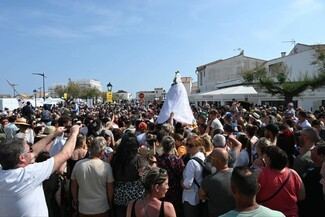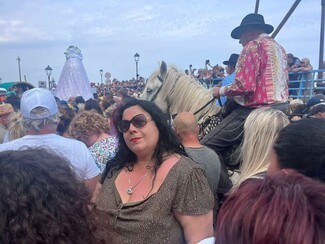“Cloaked in fine lace silk and mystery” - Saint Sara e Kali

Scrap merchant and 4th-generation horse-dealer Kerensa Smith writes about her pilgrimage to Saintes Marie De La Mer to mark Saint Sara e Kali day – the Patron Saint of the Romani people
In this world that is ever-changing, we may not believe we have time to go on a pilgrimage when the fact is- we really don’t have time not to.
This journey will take you to Saintes Marie De La Mer, the very holy seaside fishing town that gave refuge to the saints Mary Jacobe, Mary Salome and Mary Magdalene et alia.
Sara e Kali was a tribe woman who dealt in metal on the banks of the banks of the Rhône.
Whilst sleeping one night, Sara had a revelation that the saints who were at the cross when Jesus was crucified and witnessed the resurrection were in trouble on the sea. The vision told Sara that she must help them. On waking, Sara looked across the bay and sure enough, she could see a small raft in peril. With that, Sara threw her silk cloak onto the sea and it held her above the waves. When she was close to the raft she climbed aboard, her cloak tussled and flew in the wind attaching itself to the raft and pulling its weak timbers, fast acting as a sail, guiding it toward the bay.
The Marys baptised Sara and taught her the gospel. Mary Magdalene regained her strength and then set off across France spreading the word of Christ followed by her brother, Lazarus, along with the other saints who were on board.
Mary Salome and Mary Jacobe who were Jesus’ aunties, and half-sisters to the Virgin Mary lived out their days in Saintes Marie De La Mer. Their celebration is on the 25th of May. Sara e Kali’s day is May 24th.

The Roma have been recorded in the Camargue since the fourteen hundreds. Vincent Willem Van Gogh painted the Les Roulottes, campement de Bohémien (Encampment of Gypsies with Caravans) in 1888 after he had been to the festival in Saintes Marie De La Mer. There had been times when there was malaria on the marshes causing circumvention from the area and maybe some got used to this -but in 1935 the Marquis of Baroncelli made it official that the Roma would carry their patron saint to the sea and as it was then, so it is today. The Roma don’t just attend the festival they are the protagonists.
Sara's relics have been lowered from the church’s belfry, and her statue is lifted by her devoted Roma from her crypt, through the church after the Mass and onto the street where the Roma young and old, wait at the church door from the candlelight into the daylight. Sara is beautiful; wearing a white lace cloak over her many colours and layers from previous days where she has been dressed by the Roma women in the finest fabrics from faraway lands -she is carried with pride and love. Bull ranchers on white horses smoothly escort her through the streets to the sea. People with photos of loved ones reach out to Sara to touch her dress. In the crowd of thousands of people, there is religious frenzy, respect, honour and love. Tourists watch on as the Roma follow into the sea and their saint is emersed in the waters. Horses and people clamber out of the water where Sara E Kali is held high and strong. Viva Saint Sara.
As the procession makes its way back to the church, a black sky moves towards the sea like a chiffon curtain, the crowds look and point to the heavens when they open up and lightning strikes into the waves.
Some ask who is Sara e Kali. Where does she come from? I’ve told you the folk law story, in other stories she is not recognised as a saint.
When you pray to her you will find what you need, but do not ask her where she comes from, for she will not tell you, she is cloaked in fine lace silk and mystery and if you look into her eyes you know she is Saint Sarah e Kalie, Patron Saint of the Romani people.
Words and photographs by Kerensa Smith, video by Lettie Maclean, for TT Features